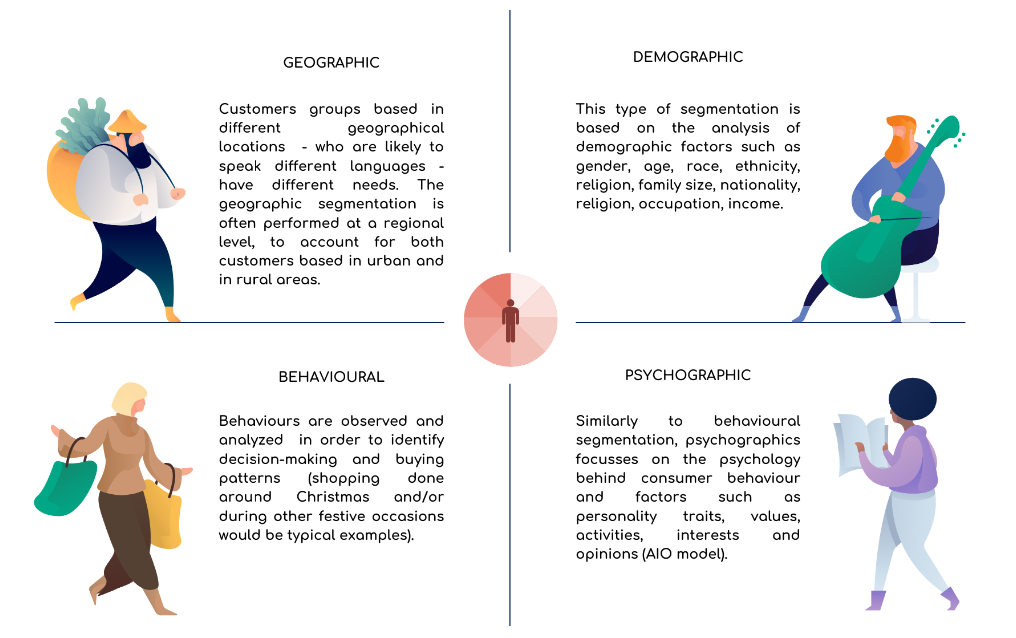Buyer Personas: An Introduction to Psychographic Segmentation
What really decides consumers to buy or not to buy is the content of your advertising, not its form.
- David Ogilvy -
Last week’s article gave us an insight into a McDonald’s marketing campaign implemented in 2012 that targeted minority groups and its unfortunate outcome: not only the language was not understandable for many of the intended target consumers, but also the product (black coffee) failed to meet their preferences.
“Once the mistakes are fixed, will the ads catch on? McDonald’s is popular the world over, but Thai Lee [a former chief resident at St. Joseph’s Hospital in St. Paul] points out that coffee is not a traditional staple of the Hmong diet. At the Hmong Village Marketplace in St. Paul, it’s common to see patrons enjoying Vietnamese-style iced coffees, hot teas and cold ‘bubble tea‘ with chewy tapioca pearls, but you’d be hard pressed to find a cup of joe.
Henry [Louis Henry, who at the time operated eight McDonald’s restaurants within St. Paul and Maplewood] isn’t fazed. After all, ‘when in Rome’.
‘If you notice, the younger generation, a lot of the young people do drink coffee’, he said.”.[1]
What could have led to a marketing campaign better suited to meet the needs of the Hmong community?
The answer is: market segmentation [segments are those sub-groups of consumers who share common characteristics], something McD’s failed to perform prior to the launch.
The four main types of market segmentation are:

With regard to psychographis - a term coined around the middle 60s by market researcher Emanuel Demby to define the variations in values, behaviours, and attitudes typical of a specific demographic segment [2] -, there’s different ways to group consumers according to psychographic criteria, for instance:
- Lifestyle, especially relevant in retail and often adopted by the automotive industry;
- Social Status, tied to buying power of the customer and mostly adopted - in combination with lifestyle - by premium brands such as Ferrari, Louis Vuitton, etc.;
- Attitudes, Interests, Opinions, concerned with deep inner drivers such as environmental concerns, politics, views on religion, cultural pursuits, preferred by digital/content marketing;
- Personality traits, an approach that revolves around customers’ need for identification with a brand and its “personality”. Consider for example the following consumer segments:




In relation to the previously mentioned McD’s campaign, psychographic segmentation might have helped the brand pick up on the “Boba culture” trend - popular among Asian-American millennials since the early 2000s - that over the years elected boba (bubble tea) as one of the symbols of the Asian-American diaspora: “Here, bubble tea, as in the material world of boba shops, is more than just a drink. Like other alimentary items that have become tokens of Asian-American popular culture — rice, dumplings, pho, soy sauce, Korean barbecue — it’s an identity.” [3]
Other examples of poor market segmentation discussed in the past include the Pampers launch campaign in Japan (from both a demographic and a psychographic perspective), McD’s kneeling man commercial in China, Starbucks expansion plan in Israel, while a notable instance - among several others - of segmentation “done right” is represented by Toyota’s marketing campaign for the launch of its Camry in 2017 (“Different Ads, Different Ethnicities, Same Car”):
“The company recently unveiled the numerous ads it had made for the car, several designed to resonate specifically with African-American, Hispanic or Asian-American audiences. Viewed together, the ads — and their different story lines, music and actors — offer a glimpse into how race and culture figure into American advertising today, showing how an ad for one product can evolve depending on who is making it and whom it is marketed to.” [4]
“What we found with African-Americans is style really comes to the forefront in how we look at vehicles,” said Lewis Williams, Burrell's chief creative officer. “We see automobiles as extensions of ourselves, so style is really important.” [Commercial: “Strut” - Agency: Burrell]
**********
“In the commercial titled ‘Captivating’, a Chinese-American father picks his daughter up from baseball practice in a red Camry. The father was specifically cast to ‘highlight a not-often-seen behavior,’ said Julia Huang, interTrend’s chief executive, who is Taiwanese-American. ‘Traditionally, Asian fathers show less emotion and affection toward their kids,’ Ms. Huang said. ‘We wanted to show that driving the Camry brought out a different side of an Asian dad and how he wanted to share the experience with his daughter’.” [Commercial: “Captivating” - Agency: Intertrend]
**********
“The ad, called ‘Rebellious,’ shows a young man in a red Camry zooming down a highway when he sees his mother is calling his phone. He hesitates before deciding to decline the call, breaking into a smile and focusing on the joy of the drive. It uses a model that ‘takes into account how long a person was in the United States, if they were born here, which language they speak, which culture they tend to feel more connected to,’, said Jennifer Dellapina, group strategic planning director at Conill. It’s a Hispanic thing — you’re going to talk to your mom once a week. It’s sort of implied in my mind that he’s going to call her back later”. [Commercial: “Rebellious” - Agency: Conill]
**********
Can you recall any examples of marketing campaigns that resonated particularly well with you, or those that failed to hit the mark? What did or didn’t work?
SOURCES:
[1] Twin Cities Pioneer Press - Online:
https://www.twincities.com/2012/09/01/st-paul-mcdonalds-hmong-pitch-mangles-language/
[2] Demby Emanuel H. (1989). "Psychographics Revisited: The Birth of a Technique". Marketing research : magazine of management and applications (Journal). Chicago, Ill : American Marketing Association
[3] Eater - Online:
https://www.eater.com/2019/11/5/20942192/bubble-tea-boba-asian-american-diaspora
[4] The New York Times - Online:

